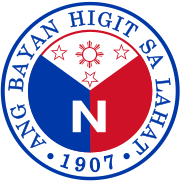
Back Partido Nacionalista BCL Partidong Nacionalista CEB Nationalistische Partei (Philippinen) German Partido Nacionalista (Filipinas) Spanish Parti nationaliste (Philippines) French Partai Nacionalista ID Partito Nazionalista delle Filippine Italian 국민당 (필리핀) Korean Улутчул партия (Филиппиндер) Kirghiz Национална партија (Филипини) Macedonian
Nacionalista Party Partido Nacionalista | |
|---|---|
 | |
| President | Manny Villar |
| Chairman | Cynthia Villar |
| Secretary-General | Mark Villar |
| Founder | Manuel L. Quezon Sergio Osmeña |
| Founded | April 25, 1907 |
| Headquarters | Starmall EDSA-Shaw 4F, EDSA corner Shaw Boulevard, Mandaluyong, Metro Manila |
| Youth wing | Young Nacionalistas (YN) |
| Membership | 1.2 million |
| Ideology | Populism[1][2][3][4][5] Conservatism[6][7] National conservatism[8] |
| Political position | Centre-right[9][7][10] |
| National affiliation | UniTeam (2021–present) Coalition for Change (2016–2021) Team PNoy (2013) Genuine Opposition (2007) K4 (2004) PPC (2001) GAD (1987) UNIDO (1980–1986) |
| Regional affiliation | Asia Pacific Democrat Union |
| Colors | National colors: Red, blue, and white Customary: Light green Orange |
| Slogan | Ang Bayan Higit sa Lahat (The Nation Above All) |
| Seats in the Senate | 4 / 24 |
| Seats in the House of Representatives | 36 / 316 [11] |
| Provincial governorships | 10 / 82 |
| Provincial vice governorships | 10 / 82 |
| Provincial board members | 116 / 1,023 |
| Website | |
| www | |
The Nacionalista Party (Filipino and Spanish: Partido Nacionalista; lit. 'Nationalist Party') is the oldest political party in both the Philippines and in Southeast Asia in general. It is responsible for leading the country throughout most of the 20th century since its founding in 1907; it was the ruling party from 1935 to 1946 (under Presidents Manuel L. Quezon and Sergio Osmeña), 1953–1961 (under Presidents Ramon Magsaysay and Carlos P. Garcia) and 1965–1978 (under President Ferdinand Marcos).
- ^ Bertrand, J. (2013). Political Change in Southeast Asia. Cambridge, UK: Cambridge University Press.
- ^ Berneo, N.; Yashar, D. (2016). Parties, Movements, and Democracy in the Developing World. New York: Cambridge University Press USA.
- ^ Celoza, A. Ferdinand Marcos and the Philippines: The Political Economy of Authoritarianism. Connecticut, USA: Greenwood Publishing Group. Retrieved September 19, 2017.
- ^ Simbulan, D. (2005). The Modern Principalia: The Historical Evolution of the Philippine Ruling Oligarchy. Quezon City: UP Press.
- ^ Del Rosario, Simon G. (1973). An Integrated Course on Communism and Democracy. SGR Research & Pub.
- ^ Cite error: The named reference
Neoliberalismwas invoked but never defined (see the help page). - ^ a b Guillermo A. Historical Dictionary of the Philippines. Maryland, USA: Scarecrow Press. Retrieved February 21, 2019.
- ^ Teehankee, Julio (2016). "Weak State, Strong Presidents: Situating the Duterte Presidency in Philippine Political Time". Journal of Developing Societies. 3 (3).
- ^ Cite error: The named reference
upcpawas invoked but never defined (see the help page). - ^ M. Troy Burnett, ed. (2020). Nationalism Today: Extreme Political Movements around the World [2 volumes]. ABC-CLIO. p. 584.
- ^ Arcangel, Xianne (November 15, 2023). "PDP-Laban's membership dwindles, Lakas-CMD now dominant House party". CNN Philippines. Archived from the original on November 16, 2023. Retrieved November 16, 2023.
© MMXXIII Rich X Search. We shall prevail. All rights reserved. Rich X Search